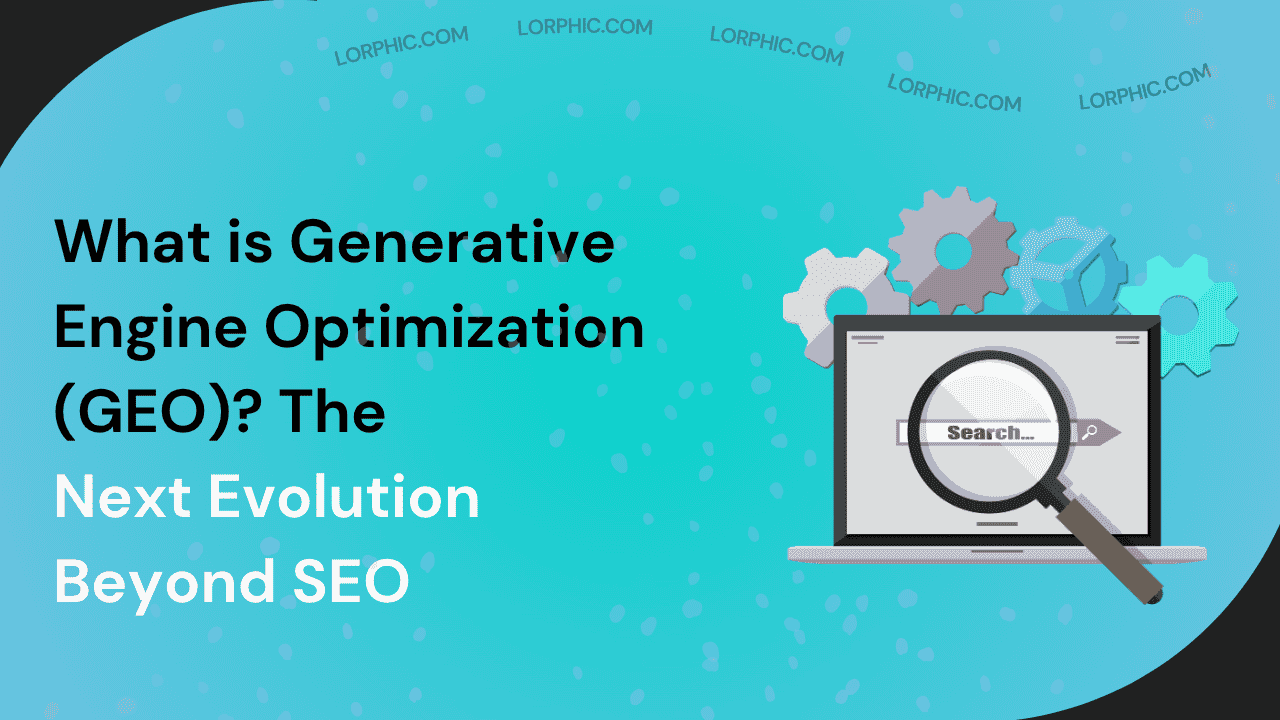Search is changing faster than ever, and the way we improve content for it is also evolving. With the growth of AI-based tools like Google’s Search Generative Experience, ChatGPT, and Perplexity, the usual SEO methods are no longer enough to stay visible online. This is where Generative Engine Optimization, also known as GEO, becomes important. It is the next big step beyond traditional SEO.
GEO helps you improve your content not only for search engines but also for AI tools that create summaries, give answers, and talk directly with users. In simple terms, GEO makes your content easy to find in the world of AI-generated answers, not just on regular search results. In this blog, we will explore what is Generative Engine Optimization, how it works, and why it is becoming essential for modern marketers and businesses.
What is Generative Engine Optimization (GEO)?
Generative Engine Optimization, or GEO, is the process of improving your online content so that it can be easily found, understood, and used by AI-based search systems such as ChatGPT, Gemini, and Claude.
While traditional SEO focuses on helping websites appear in search results, GEO makes sure that your content is chosen and trusted by AI tools when they create responses for users.
In simple words, SEO helps people discover your website, while GEO helps artificial intelligence tools find and include your content in their answers.
The Main Idea Behind GEO
Generative engines work differently from regular search engines. They depend on:
- Understanding context instead of only focusing on keywords.
- Natural and meaningful language instead of keyword repetition.
- The reliability of the source instead of only counting backlinks.
This means that to optimize for GEO, your content must be written in a clear, informative, and trustworthy way. It should provide accurate details and be easy for AI systems to understand. According to Search Engine Land, GEO refers to the process of optimizing content so that it is more visible to AI-driven search systems rather than just traditional search engines.
Why is Generative Engine Optimization Necessary?
The way people search for information has completely changed. Today, users do not just type short keywords like “best SEO tools.” Instead, they ask complete and detailed questions such as: “Which SEO tools are best for generative engine optimization for startups?”
Artificial intelligence tools now analyze these long and complex questions to give direct answers, often without showing or linking to multiple websites. This new behavior has changed how online visibility works.
Here are the main reasons why Generative Engine Optimization has become essential:
- Decline in Website Clicks: AI summaries appear before regular search results. This means users get their answers immediately, reducing the number of clicks to individual websites.
- Shift in How People Discover Information: Users now prefer quick and clear answers from AI chats instead of scrolling through many pages or websites.
- Higher Competition for Visibility: Many brands are trying to appear in AI-generated answers, so your content must be properly structured and trustworthy to stand out.
- Need for Content that AI Understands: GEO helps businesses create content that AI tools can easily read, trust, and include in their responses.
In simple terms, Generative Engine Optimization connects your content with artificial intelligence systems. It ensures your brand stays visible and relevant in a world where AI tools are becoming the main source of information.
How Does GEO Work?
Generative Engine Optimization works on the same basic idea as traditional SEO but focuses more on how artificial intelligence understands language and context. Instead of improving content only for search algorithms, GEO helps AI systems read, interpret, and use your content effectively.
Below is a simple explanation of how GEO functions step by step.
1. Create Clear and Meaningful Content
Artificial intelligence tools learn by understanding natural language. For this reason, your content should be clear, well-structured, and easy to follow.
- Explain terms and ideas in a simple way.
- Use headings and short paragraphs to organize your content.
- Avoid confusing or overly technical language.
This approach helps AI models quickly identify the key message and intent behind your writing.
2. Add Structured Data and Organized Information
Structured data helps AI understand how different elements on your page are related. Including schema for products, services, reviews, and frequently asked questions allows AI systems to recognize your content’s purpose. This makes your page more visible in AI-generated answers and summaries.
3. Provide Direct and Informative Answers
Generative engines value content that gives full and clear responses to common questions. Writing around specific queries, such as “How can I measure the success of GEO strategies,” improves your chances of being featured in AI responses.
4. Strengthen Experience, Expertise, Authority, and Trust
AI prefers reliable sources. Highlight your expertise through credible data, author information, and transparent references. This builds confidence in your content and increases its likelihood of being cited.
5. Keep Track of AI Mentions
Several tools can now help you track when your content appears in AI-generated answers. Monitoring these mentions allows you to see how well your GEO strategy is performing and where to make improvements.
Differences Between GEO and SEO
Generative Engine Optimization and Search Engine Optimization may sound similar, but their goals and methods are quite different. While both aim to make content visible and valuable, the way they achieve that visibility has evolved with the rise of artificial intelligence.
Traditional SEO has always focused on ranking web pages in search results. It works by optimizing keywords, backlinks, and other on-page elements to improve a site’s position on search engines like Google or Bing. The higher your ranking, the more likely users are to click and visit your website.
Generative Engine Optimization, on the other hand, focuses on helping artificial intelligence tools understand and include your content when generating answers. Instead of aiming for a top position on a search page, GEO aims for recognition within AI-generated responses from systems like ChatGPT, Gemini, or Perplexity.
Here is a clear comparison of the two approaches:
| Feature | Traditional SEO | Generative Engine Optimization (GEO) |
| Main Goal | Rank web pages in search engine results | Get mentioned or referenced in AI-generated responses |
| Optimization Focus | Keywords, backlinks, and on-page elements | Context, clarity, accuracy, and factual authority |
| Primary Platforms | Google Search, Bing, and Yahoo | ChatGPT, Gemini, Perplexity, and Copilot |
| Content Type | Blog posts, landing pages, and optimized web copy | Conversational and question-based content |
| Measurement Metrics | Rankings, click-through rates, and backlinks | AI citations, visibility in responses, and brand mentions |
In short, SEO helps your website get noticed in search results, while GEO ensures your content becomes part of the answers that artificial intelligence delivers. Both strategies complement each other and are essential for maintaining visibility in today’s changing digital world.
Will GEO Replace SEO?
Not quite, but it will certainly change the way we think about search optimization.
Search Engine Optimization will continue to play an important role in helping people discover websites through traditional search results. It remains the foundation of online visibility, especially when users still rely on search engines to browse and compare information.
However, Generative Engine Optimization is reshaping the next phase of online discovery. In an internet led by artificial intelligence, visibility is no longer only about ranking on a page, it is about being recognized and trusted by AI systems that summarize and deliver information directly to users.
Rather than replacing SEO, GEO should be seen as an evolution of it. Both approaches will work together to create a complete visibility strategy, SEO will keep driving traffic to your website, while GEO will help your content appear in AI-generated conversations and summaries.
Marketers who adapt early and learn to balance both strategies will have a stronger advantage. The future belongs to those who optimize not just for search engines but also for artificial intelligence understanding and engagement.
Final Thoughts
Generative Engine Optimization marks a significant shift in the world of digital marketing. It is not about replacing traditional SEO but about adjusting to how people and artificial intelligence systems now access and interpret information.
In this evolving environment, visibility is no longer measured only by rankings. What truly matters is how effectively your content can connect, communicate, and build trust with both humans and AI models.
To stay competitive, your content should:
- Interact naturally with AI systems, not just aim for top search positions.
- Deliver detailed, factual, and context-rich insights that intelligent engines can rely on.
- Strengthen your brand’s credibility and authority across every digital platform.
As generative search continues to grow, the future of visibility will belong to those who understand how to speak both the language of people and the logic of machines. In short, success in the next era of search will depend not only on being found, but on being clearly understood.
FAQ’s
What is Generative Engine Optimization (GEO) in simple terms?
Generative Engine Optimization (GEO) is the process of optimizing your content so that AI-driven search tools like Google SGE, ChatGPT, or Perplexity can easily understand, trust, and reference it in their answers. Instead of just ranking higher on Google like traditional SEO, GEO focuses on helping AI engines include your content in generated responses, making your brand visible in conversational search results
How does Generative Engine Optimization work?
Generative Engine Optimization (GEO) works by making your content easy for AI search tools like ChatGPT or Google’s SGE to read and understand. It’s about writing in a clear and natural way, answering questions directly, and organizing your content so it’s easy for AI to pick up. GEO also uses structured data (schema) to help machines know what your page is about. The goal is to make sure when people ask questions through AI tools, your content becomes part of the generated answers they see.




